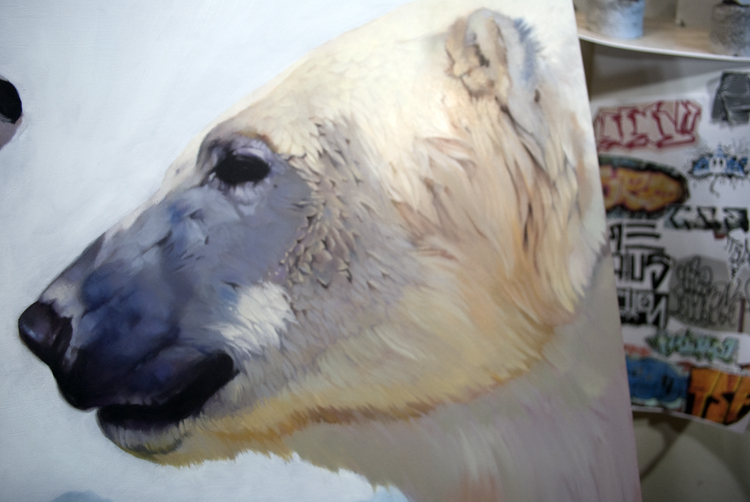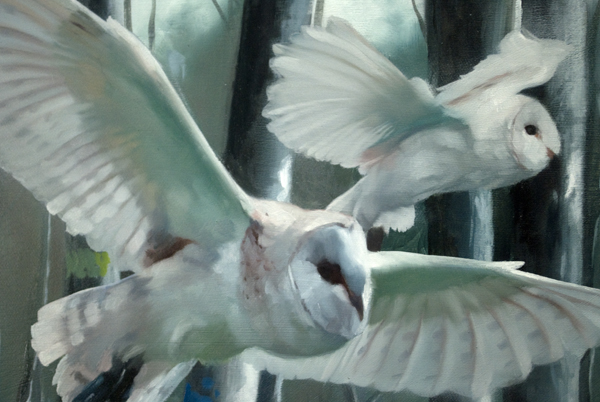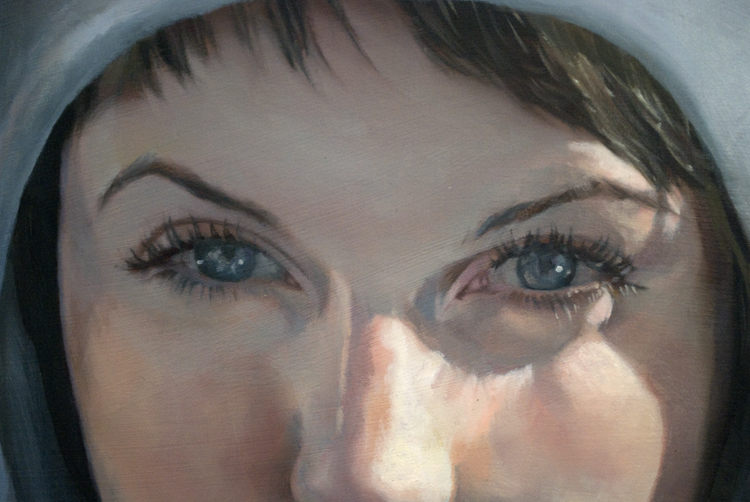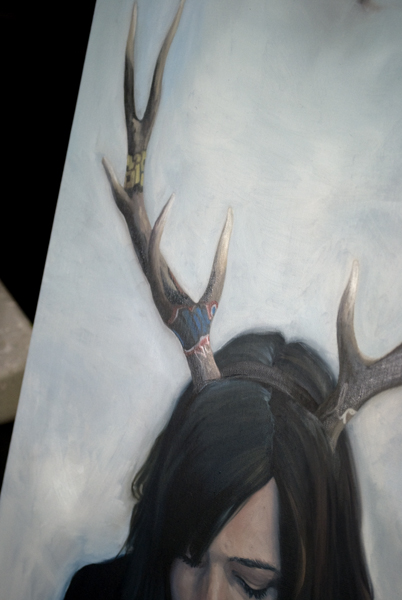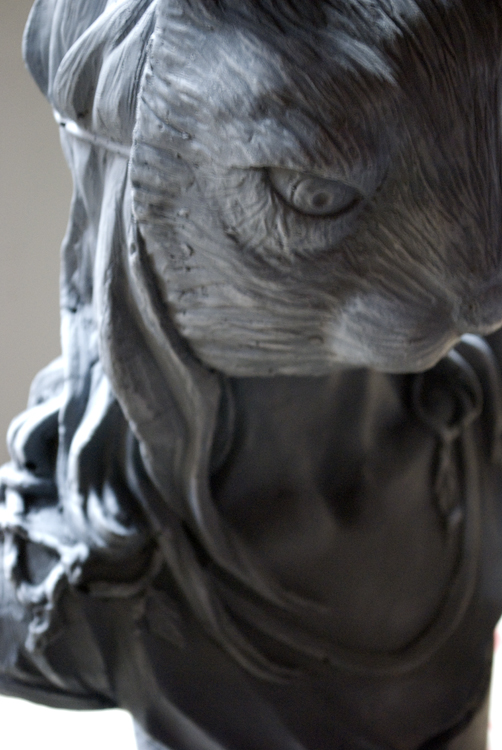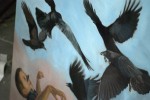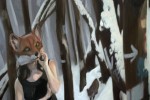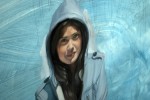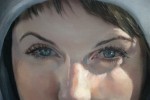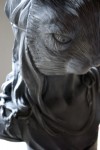One of the brightest stars to have risen out of the ever-evolving New Contemporary movement this year is without a doubt Nate Frizzell. A year ago this month, Nate first made waves with his debut solo at LeBasse Projects, Lost in the Thicket (covered). Now armed with arsenal of oil paints in place of acrylics, a refined vision and purpose as well as a new cast of characters and stories, Nate is set to unveil his newest body of richly rendered paintings, along with his first sculptural works, entitled I Should Know Who I Am By Now (teased). Opening November 6th back at the Culver City gallery where it all began, the exhibit is a leap forward in the execution of his vision, where anthropomorphic characters are nestled deep within a stark wooded winterland in the company of their kindred spirits, the only remnants of the urban world being the spray paint artifacts left upon the trees.
In the chaos of it all, Nate was generous enough to field some questions aimed at shedding some light on the young, yet exceptionally talented artist. To compliment his insightful comments, we have a set of preview images from Nate’s studio to share.
Full interview and preview images after the jump.
Arrested Motion (AM): To start, could you provide us with a little background info. Age? Location? Hometown? Favorite band?
Nate Frizzell (NF): I’m 26 years old. I was born in Oakland but spent most of my life in Riverside, California. I came out to LA in ’02 for school and I’ve been here ever since. I’m not sure I could choose a favorite band. I’m ridiculously indecisive. But lately I’ve been listening to ‘We Were Promised Jetpacks’ and ‘Riceboy Sleeps’ a whole bunch.
AM: What is your earliest artistic memory? What lead you down the path towards becoming a professional artist?
NF: When I was little I had a bunch of these oversized ‘how to’ drawing books. I think I got them from my Dad. Everyone tells me I got my artistic ability from him but I don’t think I ever saw him even draw anything when I was growing up. I used to ask him to draw me something and he would just say, “you draw it. You can do it better than I can.” Which I always assumed was his nice way of telling me no. Now that the kids are out of the house though, I think he has more time on his hands and he does some pretty ridiculous digital paintings. So maybe they’re right.
Anyway, I’ve been drawing since as far back as I can remember and my family always encouraged it. Art school was the obvious choice after high school but I didn’t have any real direction. My major was illustration which may as well have been called “don’t be an illustrator” and after graduating college I still didn’t know what I was going to do. After a miserable year or so as a graphic designer I found a gallery that liked my paintings. The owner was a great dude who was willing to be patient with me as I grew and found my way around a brush. And I’ve been lucky enough to have been painting and showing ever since.
AM: Could you walk us through your creative process? What does it take for a concept to come to fruition as a finalized painting? Do you work best during the day or night?
NF: I usually sit down play around in my sketchbook for a bit. After I have a good idea of what I want to do, I’ll go out and shoot whatever reference I can and I’ll look to books or the interwebs for the things I can’t (such as wild animals). When I have everything figured out, I build my canvas, cross my fingers, and dive in.
I don’t know that it matters what time I paint. Once I start, I usually can’t stop until it’s hard to keep my eyes open. When I’m in the middle of working on a show, my hours can get pretty nutty. Lately I’ve been waking up at around 12-1pm and painting until about 4-5am.
AM: Is there an overarching theme for this newest body of work, I Should Know Who I Am By Now?
NF: There are a couple things going on in this show. The first thing you’d probably notice is that just about every painting has a cold winter setting. But each painting is still about self discovery…finding out who you are and what you want to be. I’ve unmasked a lot of the characters and related them to animals in different ways. I’m trying to convey a bit more confidence in the subjects while balancing that with their cold, bare surroundings to show how fragile they still are.
AM: We know you’ve made the transition from painting with acrylics to working with oils in the past year. What was the impetus behind this move? How was the experience? Are you fully comfortable with oils at this point?
NF: I had always been a bit intimidated to try oils. It looked like a big setup and aside from fear of failure, it seemed like a lot more work. Plus I figured I was doing fine with acrylic so why bother switching it up. But as I get older and get more serious about art, I want to push myself more. I realized I was nowhere near where I wanted to be with my work and I needed to push past my comfort zone if I wanted to grow. I looked at a lot of my favorite painters and saw that they all painted in oil and I figured it was time to move forward. So I bought a cheap set and some turpenoid and went for it.
I couldn’t believe how much I liked it. I don’t know what it was exactly. I liked the way the paint hit the canvas and how nice it was to move around. And it seemed to be a lot more forgiving. At first, I was using it the same way I would have used the acrylics and my paintings weren’t much different. They may have been a bit more vibrant and a little more detailed, but it wasn’t a huge improvement. So over this past summer I ordered a few books and magazines and went to museums and searched online and tried to soak up as much info about how to handle the medium that I could. I’ve been experimenting with different techniques and trying new mediums and I’m getting more familiar and comfortable with each painting. Every piece I make seems to be a little better than the one before. But I definitely haven’t finished learning and I hope I can keep progressing and get even more comfortable.
AM: In comparing last years solo with this one, what is the biggest stylistic or conceptual difference between the two?
NF: Conceptually, the show is pretty similar. But I think stylistically, the show is a big improvement. Whether it’s the new medium or just the experience earned over the past year, the paintings are a lot more focused and lifelike.
AM: Street art is commonly layered within the background of your work. What is the thinking behind this? Do you have any street art background? Or is it more a matter of these works and artists being such a pervasive part of the collective art lexicon at the moment?
NF: I’ve always been a big fan of street art and used to buy magazines in high school and be super jealous of the people who created these crazy pieces. Unfortunately, no matter how much I scribbled on paper, I was never any good at that sort of thing myself and I stuck to drawing from life. Which pretty much just shows how much more creative these artists out there are than me. But aside from respect, I don’t know that that has much to do with why I use it in my paintings.
For the past few years, I’ve been living in Downtown LA and I’m surrounded by graffiti on almost every corner of my neighborhood. The graffiti in my paintings is a sort of way to merge my real world with the world I imagine in my head. It’s an attempt to bring the viewer with me into my imagination. I’ll often use more simple tagging and more recognizable pieces to make it easier for the viewer to connect.
AM: Animals play an integral roll in your work, almost as important – if not more so – than the people themselves. Could you talk about what they symbolize and how they relate to the human characters?
NF: I’ve always been interested in the symbology different cultures have for all kinds of animals. But it’s a little more than that. I don’t think you need to know anything about that when you see animals in the wild or watch them on the screen. They have basic needs and wants and characteristics and you can see it in the way they look and in the way they move. People are constantly putting on masks to hide what they are really thinking or feeling. I use the animals in the paintings to show what the subject might strive to be more like or sometimes what they may want to overcome.
AM: What artist(s) are inspiring you today?
NF: There are so many ridiculously great artists out there. I am constantly seeing new work all over the place and once I get over the initial jealousy, I am completely inspired. I couldn’t possibly name all the artists I’m loving right now. But there is one guy, Richard Schmid, whose book I bought a recently. If I could be able to paint at his level someday, I’d be a happy man.
AM: What’s in store for you down the road? Any secrets your can let your fans in on as far as future shows or projects?
NF: I get stressed out enough with each show, I try not to think too far past it. But I will have my first sculpture in this upcoming show and I’m so happy with it, I will definitely be doing more in the future.
AM: Congrats on the an exceedingly successful year and thank you for your time. We cannot begin to convey how excited we are for this show.
NF: Thanks a lot! Me too.
Opening reception Saturday, November 6th from 7 – 10PM, with Nate in attendance.
LeBasse Projects
6023 Washington Blvd.
Culver City, CA 90232




